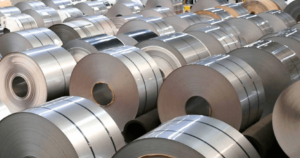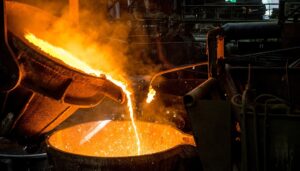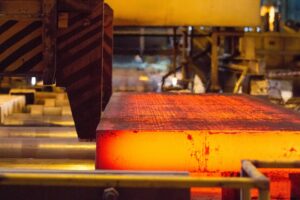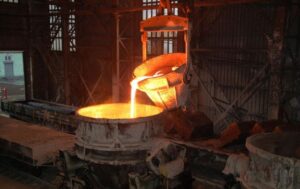
Global demand for steel in 2025 will remain at the previous year’s level — about 1.748 billion tons, after a 1.6% decline in 2024. These figures are given in the short-term forecast of the World Steel Association (Worldsteel) — Short Range Outlook (SRO).
In 2026, according to experts, demand will grow by 1.3% to 1.772 billion tons, driven by recovery in Europe, India, and the rapidly developing countries of Asia, the Middle East, and Africa.
According to Worldsteel’s forecast, in the CIS countries, including Ukraine, demand for steel will decline by 5.2% in 2025, to 56.1 million tons, and by another 1.7% in 2026, to 55.2 million tons.
At the same time, India will retain its status as the world’s fastest-growing steel market, with growth of around 9% annually in 2025-2026. Already next year, steel consumption in India will be almost 75 million tons higher than in 2020.
In developing countries (excluding China), demand for steel will increase by 3.4% in 2025 and by 4.7% in 2026, driven by active economic development in ASEAN countries, as well as in Saudi Arabia and Egypt.
In Africa, steel consumption is growing by an average of 5.5% annually, reaching 41 million tons in 2025 — the highest level in the last decade. Growth is driven by investments in construction and improved macroeconomic indicators.
Andriy Ozeychuk, Chairman of the Board of Directors of the Ukrainian Steel Construction Center and Director of Rauta, commented on the market situation and prospects for the Ukrainian steel sector.
“The Ukrainian steel market in 2025–2026 will be shaped by the recovery of domestic demand in construction and machine building, as well as the growth of exports of metal structures to the EU. We predict that demand for steel in Ukraine may grow by 6-8% in 2026 due to infrastructure and industrial recovery projects,” Ozeychuk said.
According to him, the steel construction sector will be the driver of this growth:
“The use of metal structures will accelerate the restoration of logistics, industrial, and infrastructure facilities.”
Ozeychuk also stressed that the launch of joint programs with European partners in the field of “green” metallurgy, where Ukraine already has its first pilot initiatives for the production of steel with a low carbon footprint, could give the industry an additional boost.
According to the forecast, demand for steel in the EU+UK region will increase by 1.3% in 2025 and by 3.2% in 2026. This reflects the impact of increased investment in infrastructure and defense amid lower inflation and improved household incomes.
In the US, Worldsteel expects steel consumption to increase by 1.8% in both 2025 and 2026. The main drivers of growth will be government spending on infrastructure, a revival in housing construction, and private investment.
In China, steel demand will continue to decline, by approximately 2% in 2025, due to the prolonged downturn in the real estate market. In 2026, the rate of decline will slow to 1% as the construction sector is expected to bottom out.
Worldsteel warns that a more challenging global trade environment and financial pressure on local authorities could further limit infrastructure investment and reduce demand.
According to Alfonso Hidalgo de Calcerrada, chief economist of the Spanish Steel Manufacturers Association (UNESID) and chairman of the Worldsteel Economic Committee, the organization is “cautiously optimistic” about the market outlook:
“Despite trade disputes and uncertainty, we believe that global steel demand will bottom out in 2025 and show moderate growth in 2026,” the expert said.
He added that this will be facilitated by the resilience of the global economy, growth in infrastructure investment, and easing financial conditions. At the same time, the sector continues to be pressured by high costs, trade barriers, and geopolitical risks.
Worldsteel’s forecast emphasizes that the decline in demand in China is offset by strong growth in India and developing countries, where a new center of global steel production is emerging.
In addition, the protective measures introduced by the European Union — reducing duty-free import quotas and increasing customs duties to 50% — may change the balance between EU producers and exporters from Asia and Eastern Europe.
For more information on the largest steel producers and global industry trends, see the Experts Club video analysis review available on YouTube: Experts Club — Leaders of the global steel industry 1990–2024
CHINA, EU, EXPERTS CLUB, global economy, INDIA, OZEYCHUK, RAUTA, USA, World Steel, WORLDSTEEL

In July 2025, Ukrainian metallurgical enterprises produced 581,000 tons of steel (down 18.1% year-on-year and down 6.4% month-on-month), ranking 23rd in the Worldsteel rating of 70 countries. In January–July, production amounted to 4.263 million tons (–7% y/y), with Ukraine ranking 22nd for this period.
According to Worldsteel, India, the US, Turkey, and Iran showed growth in July compared to last year, while the other countries in the top 10 recorded a decline.
The World Steel Association is an international association of the steel industry, bringing together steel producers, national and regional industry associations, and research institutes; its members account for about 85% of global steel production. Its headquarters are in Brussels, and it has an office in Beijing. The organization was founded in 1967 as the International Iron and Steel Institute and was renamed in 2008. Worldsteel regularly publishes monthly production statistics and an annual reference book, World Steel in Figures.

In July 2025, global steel production amounted to 150.126 million tons, which is 1.3% less than in July 2024.
According to the World Steel Association (Worldsteel), the top ten countries are as follows:
China — 79.660 million tons (-4% y/y)
India — 14.000 million tons (+14%)
United States — 7.142 million tons (+4.8%)
Japan — 6.918 million tons (-2.5%)
Russia — 5.700 million tons (-2.4%)
South Korea — 5.256 million tons (-4.7%)
Turkey — 3.182 million tons (+4.2%)
Brazil — 2.930 million tons (-5.5%)
Germany — 2.719 million tons (-13.7%)
Iran — 2.235 million tons (+29.7%)

In February 2025, Ukrainian steelmakers produced 572 thousand tons of steel, up 7.5% from February 2024. However, volumes decreased by 6.4% compared to January.
According to Worldsteel, Ukraine ranked 21st among 69 steel-producing countries. In the first two months of 2025, the country increased production by 9.9% to 1.183 million tons.
The full dynamics of steel production by the world’s top twenty countries is available on the Experts Club YouTube channel – https://youtube.com/shorts/VgUU9MEMosE?si=BMOo_LS734dXysdj

According to Worldsteel, in October-2024, half of the top ten countries, except Japan, USA, rf, South Korea and Iran, recorded steelmaking growth by October-2023.
The top ten steel-producing countries at the end of October are as follows: China (81.880 million tons, up 2.9% on October-2023), India (12.456 million tons, plus 1.7%), Japan (6.925 million tons, minus 7.8%), USA (6.551 million tons, minus 2%), Russia (5.6 million tons, minus 15.2%), South Korea (4.487 million tons, down 18.3%), Germany (3.217 million tons, plus 14.7%), Brazil (3.075 million tons, plus 16.2%), Turkey (2.998 million tons, plus 0.7%) and Iran (2.960 million tons, minus 1.9%).
Overall, in October this year, steelmaking rose 0.4% year-on-year to 151.193 million tons.
For the first 10 months of 2024, the top ten steel-producing countries are as follows: China (850.730 million tons, down 3%), India (122.982 million tons, up 5.6%), Japan (70.214 million tons, down 3.7%), USA (66.666 million tons, “minus” 1.9%), Russia (59.435 million tons, “minus” 6.8%), South Korea (52.330 million tons, minus 6.4%), Germany (31.581 million tons, plus 5%), Turkey (30.905 million tons, plus 12.4%), Brazil (28.394 million tons, up 6%) and Iran (24.956 million tons, plus 0.6%).
Overall, 71 countries produced 1 billion 546.586 million tons of steel in January-October, down 1.6% from the same period in 2023.

Metallurgical enterprises of Ukraine in April this year increased steel production by 2.04 times compared to the same period last year – up to 574 thousand tons from 281 thousand tons.
In March 2023 it was smelted 527 thousand tons of steel.
In this case, Ukraine took 22nd place in the ranking of 63 countries – the world’s main producers of these products, compiled by the World Steel Association (Worldsteel).
According to Worldsteel, in April 2023 recorded a decline in steel production to April 2022 in most of the top ten countries, except India, South Korea, Russia and Iran.
The top ten steel-producing countries in April are as follows: China (92.640 million tons, down 1.5% on April-2022), India (10.721 million tons, up 3.2%), Japan (7.239 million tons, “minus” 3.1%), USA (6.586 million tons, “minus” 5.3%), RF (6.380 million tons, “plus” 1.9%), South Korea (5,689 mln tons, more by 3%), Germany (3,197 mln tons, decreasing by 3,8%), Iran (3,063 mln tons, increasing by 5,9%), Brazil (2,773 mln tons, minus 5,9%) and Turkey (2,678 mln tons, less by 20,6%).
Overall, steel production in April this year decreased by 2.4% compared to the same period last year to 161.377 million tons.
For the four months of 2023, the top ten steel-producing countries are as follows: China (354.390 million tons, up 4.1%), India (43.897 million tons, up 3%), Japan (28.861 million tons, down 5.3%), USA (26.061 million tons, down 4.1%), Russia (25.094 million tons, down 0.6%), South Korea (22.355 million tons, minus 0.4%), Germany (12.354 million tons, down 5.9%), Brazil (10.585 million tons, minus 8.8%), Turkey (10.1 million tons, down 21.3%) and Iran (9.710 million tons, up 0.1%).
A total of 63 countries produced 622.736 million tons of steel in January-April, which is 0.3% less than during the same period in 2022.
In this case, Ukraine produced 1.809 million tons of steel, which is 2.2 times, or 54% less than in January-April 2022. Is in 25th place at the end of four months-2023.
As reported, at the end of 2022, the top ten steel producing countries were as follows: China (1.013 billion tons, down 2.1%), India (124.720 million tons, up 5.5%), Japan (89.235 million tons, down 7.4%), USA (80.715 million tons, down 5.9%), Russia (71.5 million tons, down 7.2%), South Korea (65, 865 million tons, down 6.5%), Germany (36.849 million tons, down 8.4%), Turkey (35.134 million tons, down 12.9%), Brazil (33.972 million tons, down 5.8%) and Iran (30.593 million tons, up 8%).
In 2022, Ukraine ranked 23rd with the production of 6.263 million tons of steel (“minus” 70.7%).
In total, 64 countries produced 1 billion 831.467 million tons of steel in 2022, which is 4.3% less than in 2021.